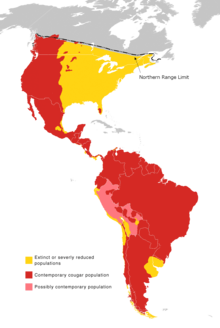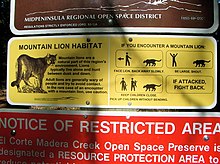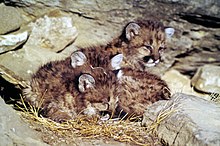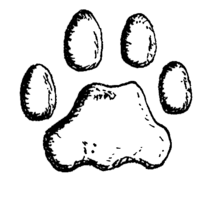puma
| puma | ||||||||||||
|---|---|---|---|---|---|---|---|---|---|---|---|---|

Puma ( Puma concolor ) |
||||||||||||
| Systematics | ||||||||||||
|
||||||||||||
| Scientific name | ||||||||||||
| Puma concolor | ||||||||||||
| ( Linnaeus , 1771) |
The puma ( Puma concolor ) is a species of cat from North , Central and South America . In his home countries he is known by numerous other names; for many of them there is also an equivalent in German: Silberlöwe , Berglöwe or Kuguar ( English cougar , from French couguar ). In the United States, it is also called panther , a name used in German mainly for leopards and jaguars with melanism . The name Puma is borrowed from Quechua .
features
Although the Puma is taxonomically not the big cats , but the small cats assigned, but is still the fifth largest cat in the world (after Tiger , lion , jaguar and leopard). The pumas native to the equator are the smallest forms, while those in the extreme north and south of the range are largest.
Its shoulder height is around 60 to 90 cm, the head-trunk length is 105 to 195 cm in males, but only 95 to 151 cm in females. In addition, the tail is between 60 and 97 cm long.
The weight of the males varies, depending on the habitat, between 53 kg and 72 kg, in more northern distribution areas it is around 100 kg. Females typically weigh between 34 kg and 48 kg. A record weight of over 125 kg has also been reported for an extremely large male.
The fur is short, dense and monochrome, but very variable in color. The most common are yellow-brown to reddish-brown and silver-gray pumas; the chin and chest as well as the entire underside are always white. The tip of the tail is dark. Newborn pumas are beige and brightly spotted; the markings faded during the first year of life. Blacklings are also documented from South America. Pumas have five toes on their front feet and four on their back feet. They can retract their claws.
Pumas are very agile and strong. They are able to jump into a tree up to 5.5 m high from the ground. Pumas make a wide range of different sounds that differ between the sexes. For example, chirping sounds apparently serve the communication between mothers and their offspring, while screams are apparently part of mating behavior. Unlike the actual big cats , however, pumas are not able to roar. North American researchers like Truman Everts describe the puma’s cry as human-like.
Pumas live to be 8 to 13 years old in the wild . They live to be over 20 years old in captivity; a North American puma named Scratch is almost 30 years old.
distribution

In the south, today's distribution area extends only to the Strait of Magellan , not to Tierra del Fuego .
Pumas used to be common over most of North and South America. No other mammal on the American continent had such a wide range. It stretched from southern Canada through Central America to southern Patagonia . Today the population is heavily thinned out and reduced to areas sparsely populated by humans. In the United States , puma survived the waves of extinction only in the Rocky Mountains , Cascade Range , Coast Mountains , in the deserts and semi-deserts of the southwest, and in the Everglades swamps of Florida . The distribution area has expanded again through protective measures, and there are now pumas again, for example in the Great Lakes area . In some regions of the American west, pumas no longer shy away from being close to cities. There is evidence that the puma reappeared in the Canadian province of Québec in 2007, although it has been considered extinct there since 1938.
Pumas can be found in almost all habitats : the prairie , boreal , temperate and tropical forests, semi-deserts and high mountains are all part of this cat's habitats.
Way of life
The puma is a loner and, except during the mating season, avoids its fellow species. The size of the home area depends on the food supply and access to sexual partners and ranges from 50 km² to 1000 km². The territories of territorial males are larger than that of the females and usually overlap with those of several females.
By avoiding each other, cougars are very peaceful with one another. Intensive marking of the territories with excrement or urine marks and also scratch marks on the trees by the males is helpful.
While the puma is able to run very fast over short distances, it rarely uses this ability. It reaches speeds of 55 km / h to 72 km / h. If he misses a prey, he does not chase after. If it is pursued, for example by wolves, it is more likely to take refuge in a tree than to walk longer distances.
nutrition
Pumas prey on mammals of almost all sizes. In North America, elk , deer and reindeer are among the prey animals of the puma, but also mice , rats , ground squirrels , skunks , raccoons , beavers and possums as well as sheep and young cattle . However, deer are its most common prey with 68% of the food they eat . The puma can also overwhelm other predators such as coyotes and bobcats . In addition to mammals, the puma also eats birds and, in some areas, fish. However, it is not a scavenger and also avoids reptiles . As in North America, deer such as white-tailed deer , spit deer , fork deer and marsh deer make up the majority of puma prey in South America. In addition, pumas kill all kinds of medium-sized mammals in South America, such as guanacos , vicuñas , viscachas , agoutis and armadillos . Overall, pumas usually strike smaller prey in the tropical parts of the range than in the northern and southern parts. This can probably be explained by the fact that in the tropics the larger jaguar usually occurs next to the puma, and the latter then deviates to smaller prey.
In order to kill a larger prey, the puma sneaks up first. From a short distance he jumps on the animal's back and breaks its neck with a strong bite in the neck.
Reproduction
As solitary animals, pumas only come together during the mating season, which is usually, but not exclusively, between November and June, for a maximum of six days before the male leaves the female a few weeks before the young are born. The gestation period is about three months. A litter has between one and six, but usually two to three young. The birth weight is between 230 and 450 grams, the size of the newborns 20 to 30 centimeters. The young take in solid food after about six to seven weeks and separate from the mother after about 20 months.
Endangerment and importance for humans
Apart from humans, cougars have few enemies to fear. Only wolves , bears and jaguars can occasionally prey on young or sick pumas. Although they are protected species, pumas are hunted by some farmers who fear for their livestock. The total population is estimated to be less than 50,000 adult animals. The species as a whole is considered, according to the Red List of Threatened Species of the World Conservation Union IUCN as not threatened ( Least Concern ).
The puma is a shy cat that usually avoids human proximity and mostly flees from people; however, there are occasional attacks and conflicts, e.g. B. when a puma attacks pets. There are said to be about four such incidents annually in the United States, but they are rarely fatal. Most of the victims of attacks against people are children; A puma only attacks adults in exceptional cases.
In February 2019, a jogger was attacked by an animal weighing 16 kg in Horsetooth Mountain Open Space Park in Colorado, USA; the jogger survived with some injuries, he managed to strangle the animal with his bare hands. Three people have been killed by puma attacks in Colorado in the past 30 years.
The puma was held in high regard by the indigenous peoples of America . They attributed qualities such as leadership, strength, resourcefulness, loyalty, commitment and courage to him.
The Iraqi- speaking North American people of the Erie have been associated with the puma because the name Erie is derived from Erielhonan , which means 'long tail' in German. This actually referred to raccoon pelts and the Indian tribes that traded with them. The French, however, wrongly related the word to the puma and therefore called the Erie the people of the cat ( Nation du Chat ).
The white colonists in North America fought the puma. Not only did they want to protect their cattle from him, but they also hunted him because he was a popular trophy.
Systematics
The closest relative of the puma is the jaguarundi , which in more recent systematics is also in the same genus, namely pumas ( Puma ). There is also a relatively close relationship to the cheetah , which used to be kept in a separate subfamily within the cats, a division that cannot be maintained from a phylogenetic point of view. In addition, at the end of the 1890s, puma herd , which are a hybrid of puma and leopard, were bred . These hybrids were short and had a greatly reduced life expectancy.
Recent genetic studies suggest that the puma is relatively closely related to the extinct North American cheetah Miracinonyx .
Subspecies
Over time, up to 32 subspecies of the puma have been described. According to molecular genetic studies by M. Culver and colleagues, there are only six subspecies that are compatible with the genetic findings. All pumas in North America hardly differ genetically from one another and represent a largely homogeneous population. The populations of Central and South America show greater variability. These findings are attributed to the fact that the ancestors of the North American Pumas only immigrated from South America around 10,000 years ago at the end of the last Ice Age. Since a number of large animal species became extinct in America around the same time, it is assumed that the puma suffered the same fate in North America, but that it was able to stay in South America and from there pushed back a little further north. This study is also accompanied by a reassessment of the extinct and threatened subspecies.
The following subspecies are recognized by Culver and colleagues and are listed in the zoological reference work Mammal Species of the World :
- North American puma ( Puma concolor cougar ), including the Eastern North American puma, which was declared extinct in March 2011, and the Florida panther: North America, northern Central America
- Central American Puma ( Puma concolor costaricensis ): Central America from Panama to approximately Honduras
- Northern South American Puma ( Puma concolor concolor ): Northwest half of South America, northwest of the mouth of the Rio Tocantins , in the southwest up to about the border with Chile and Argentina
- Eastern South American Puma ( Puma concolor capricornensis ): Eastern half of South America from the mouth of the Rio Tocantins in the north to the mouth of the Río de la Plata
- Central-South American puma ( Puma concolor cabrerae ): Southeastern South America between the Rio de la Plata and the Rio Negro in Argentina , inland to the Gran Chaco area
- Southern South American puma ( Puma concolor puma ): Chile and Patagonia
Two subspecies native to eastern North America were or are considered to be extinct. The Florida panther ( P. c. Coryi ), which survived the waves of extinction in the Everglades swamps , is particularly threatened (see below).
Anthony Caragiulo and co-workers in their published in 2014 analyzing the mitochondrial DNA of various Pumas clear signs of a northern and a southern clade within the species. In a study published in the January 2017 revision of the Cats system by the Cat Specialist Group of the IUCN therefore be only two subspecies of the puma recognized.
- Puma concolor cougar , North and Central America
- Puma concolor concolor , South America
Florida panther

Although the latest research shows that the Florida panther is not considered a subspecies in its own right, great efforts are being made to conserve this population. It was even considered extinct for a short time, but was rediscovered in 1972. Investigations showed that only less than 30 animals of these rather small, reddish colored pumas were still alive. They also had symptoms suggestive of inbreeding problems ( Cow-lips , kinked tail ). As a result, several female cougars were introduced from Texas in 1995 to support the Florida panther population. They gave birth to at least 25 offspring from male Florida panthers. Genetic tests later confirmed the success of the exposures. The pumas imported from Texas were then removed from the population.
Thanks to genetic research, it was found that some of the Florida panthers hybridized with South American puma even before the official cougar releases in 1995. How these cougars got to Florida could not be clarified. It is likely that it was either escaped or illegally released animals, as natural immigration is hardly possible.
In 2013, there were about 160 cougars in Florida. In 1995 the number was between 30 and 50. This is considered a success of the resettlement program. Many of the animals wear a transmitter collar for research purposes.
Others
- A mountain lion was also the animal lead in the Disney film The Escape of the Pumas ( Run, Cougar, Run , 1972).
- The puma has caught up with records in various disciplines: In the Guinness Book of Records, for example, it bears the title of the animal with the most names (40), is the mammal with the highest jumps at over five meters and has the largest range in the entire region western hemisphere.
- Apple's Mac OS X 10.1 computer operating system was codenamed Puma . A few years later, OS X 10.8 was named Mountain Lion ('mountain lion').
literature
- H. Maurice, N. Sharon, L. Fred: "Cougar: Ecology and Conservation" University of Chicago Press, Chicago 2010, ISBN 978-0-226-35344-9 .
- DE Brown, HG Shaw: Soul Among Lions. The Cougar As Peaceful Adversary. University of Arizona Press, Tucson 2000, ISBN 0-8165-2084-4 .
- RH Busch: The Cougar Almanac. Lyons & Burford, New York 1996, ISBN 1-55821-403-8 .
- HP Danz: Cougar! Ohio University Press, Athens (Ohio) 1999, ISBN 0-8040-1014-5 .
- J. Kobalenko: T. Kitchin, W. Hurst, Forest Cats of North America. Firefly Books, Willowdale 1997, ISBN 1-55209-172-4 .
- RM Nowak: Walker's Mammals of the World. Vol. 1. Johns Hopkins University Press, Baltimore 1999, ISBN 0-8018-5789-9 , pp. 818 f.
- M. Culver, WE Johnson, J. Pecon-Slattery, S.J. O'Brien: Genomic ancestry of the American puma (Puma concolor). In: The Journal of Heredity. 91 (3) Oxford University Press, Oxford 2000, ISSN 0022-1503 , p. 176 ff. (PDF).
Film documentaries
- The lion of America . German TV documentary by Ronald Tobias , WDR 2003, 44 minutes
Web links
- Species profile Puma; IUCN / SSC Cat Specialist Group in English
- Puma concolor in the endangered Red List species the IUCN 2009. Posted by: Caso, A., Lopez-Gonzalez, C. Payan, E., Eizirik, E., de Oliveira, T., Leite-Pitman, R., Kelly, M., Valderrama, C. & Lucherini, M., 2008. Retrieved January 25, 2010.
Individual evidence
- ↑ a b c d e R. M. Nowak: Walker's Mammals of the World. Vol. 1. Johns Hopkins University Press, Baltimore 1999, ISBN 0-8018-5789-9 , pp. 818 f.
- ↑ Mel Sunquist, Fiona Sunquist: Wildcats of the World . University of Chicago Press, 2002, ISBN 0226779998 , p. 254 ( excerpt (Google) )
- ↑ a b c d e M. E. Sunquist & FC Sunquist (2009). Family Felidae (Cats). In: Don E. Wilson, Russell A. Mittermeier (eds.): Handbook of the Mammals of the World. Volume 1: Carnivores. Lynx Edicions, 2009, ISBN 978-84-96553-49-1 , (pp. 145 f.).
- ↑ K. Nowell & P. Jackson: "Wild Cats. Status Survey and Conservation Action Plan. ” (PDF; 24.6 MB). 1996, p. 132. Retrieved April 21, 2011.
- ↑ Scratch. Cougar 1977-2007 ( Memento from November 19, 2008 in the Internet Archive )
- ↑ IUCN 2015/2010: Puma concolor
- ^ Victor Skinner: Photo shows cougar presence in Michigan . The Grand Rapids Press, November 15, 2009
- ↑ Le cougar de l'est est présent au Québec (PDF, 38.3 kB).
- ^ "Cougar facts" ( Memento from August 20, 2007 in the Internet Archive ) In: Canadian Geographic. Retrieved April 21, 2011.
- ^ A b J. Agustin Iriarte, William L. Franklin, Warren E. Johnson, Kent H. Redford: Biogeographic variation of food habits and body size of the America puma. In: Oecologia. 85, 1990, p. 185, doi : 10.1007 / BF00319400 .
- ↑ www.rcinet.ca: Lynn Desjardins: Teen saves dog from cougar attack (English) Last accessed June 5, 2013
- ↑ www.rcinet.ca: Marc Montgomery: More Couguar Attacks in Canada (English). Last accessed June 5, 2013
- ↑ Frankfurter Allgemeine Zeitung: Puma conquerors on combat: "That would be a pretty shitty way to die". Retrieved February 16, 2019 .
- ↑ "Pumapard & Puma / Jaguar hybrids" , Accessed 18 April 2012
- ↑ a b M. Culver, WE Johnson, J. Pecon-Slattery, S. J. O'Brien: Genomic ancestry of the American puma (Puma concolor). In: The Journal of Heredity. 91 (3), 2000, doi: 10.1093 / jhered / 91.3.186
- ↑ a b Anthony Caragiulo, Isabela Dias-Freedman, J. Alan Clark, Salisa Rabinowitz u. George Amato: Mitochondrial DNA sequence variation and phylogeography of Neotropic pumas. Mitochondrial DNA 25, 304-312. DOI: 10.3109 / 19401736.2013.800486
- ↑ In: Don E. Wilson, DeeAnn M. Reeder (Ed.): Mammal Species of the World . A Taxonomic and Geographic Reference. 3. Edition. Johns Hopkins University Press, Baltimore 2005, ISBN 0-8018-8221-4 (2142 pages). Retrieved April 21, 2011.
- ^ Puma concolor , Mammal Species of the World ; Accessed February 3, 2020
- ^ "US Fish and Wildlife Service concludes eastern cougar extinct" . US Fish & Wildlife Service. Retrieved April 21, 2011.
- ↑ AC Kitchener, C. Breitenmoser-Würsten, E. Eizirik, A. Gentry, L. Werdelin, A. Wilting, N. Yamaguchi, AV Abramov, P. Christiansen, C. Driscoll, JW Duckworth, W. Johnson, S. -J. Luo, E. Meijaard, P. O'Donoghue, J. Sanderson, K. Seymour, M. Bruford, C. Groves, M. Hoffmann, K. Nowell, Z. Timmons, S. Tobe: A revised taxonomy of the Felidae . The final report of the Cat Classification Task Force of the IUCN / SSC Cat Specialist Group. In: Cat News. Special Issue 11, 2017, pp. 73–75.
- ↑ Release of Texas Pumas in Florida ( Memento from January 6, 2012 in the Internet Archive ) on panthersociety.org (archived version)
- ^ Wiener Zeitung : Texas Pumas removed from Florida , March 4, 2006 (accessed November 19, 2013)
- ↑ Hybridization of the Florida panthers (PDF)
- ↑ http://www.nbcmiami.com/news/Rare-Florida-Panther-Released-Back-Into-the-Wild-in-Palm-Beach-201421021.html (accessed April 19, 2017)
- ^ The Guinness Book of World Records. 2004, p. 49
- ↑ "Phenomena in the Animal World: Exclusive Touring Exhibition 'World Champions of Nature'". Accessed April 21, 2011.



